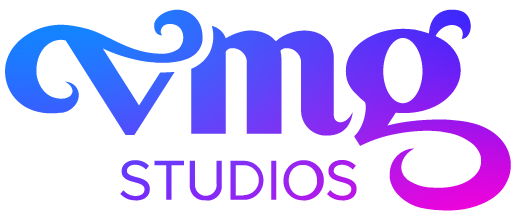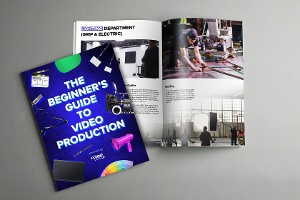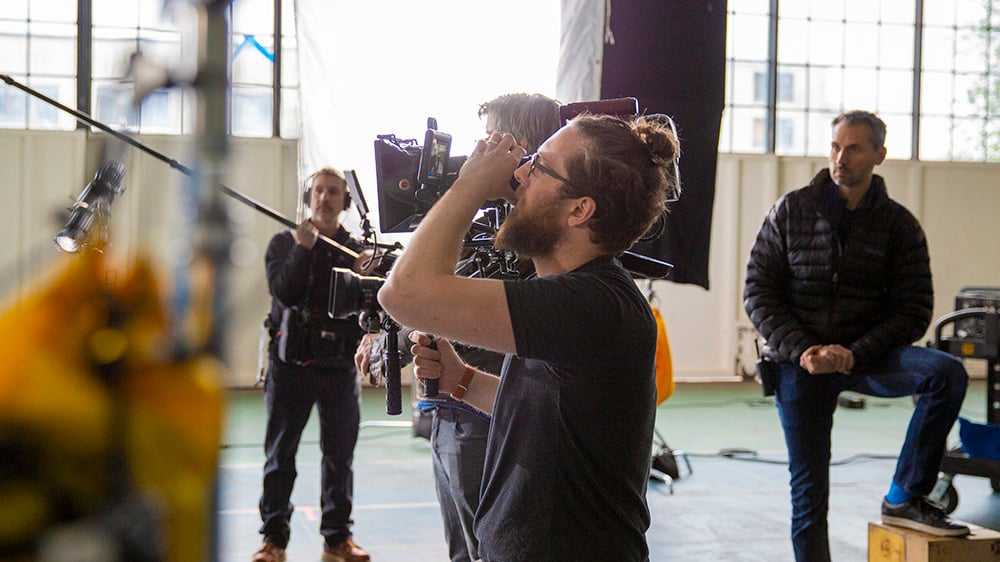
Who are all these people? What’s a Best Boy? Why does it take so many humans to shoot a short video? What does everyone on set do?
These are all questions I’ve heard from new clients and interns who are shocked to see so many people on set for a “simple” video.
Well, surprise!
There’s nothing simple about video. Not “good” video, anyway.
It takes expertise to make a quality product, and if you expect a one-man-band to be an expert in every field of video production and management, then you’re expecting too much.
This article will outline the definitions of people on set including who reports to whom.
Video Production Roles
In general, most of you reading this article aren’t going to be on the set of large blockbuster productions, so I’m going to focus on the roles you’re most likely to encounter on a small or medium-sized shoot.
I’ll also illustrate the most common hierarchy structures of who answers to whom. Knowing this can greatly improve your competence and success on set and “sets the stage” for good communication practices.
Keep in mind as we go through these, that the number of people on a shoot and how many roles each person is fulfilling can vary, depending on the production’s size.
But in general, I would expect no less than 2 to 3 people for even the smallest of shoots (camera operator, producer, and perhaps an assistant who can wear multiple hats). You might see this on a small, low-budget interview set-up.
On the flip side, more than 500 people worked on the set of Indiana Jones and the Last Crusade (and that doesn’t count the talent and extras!). Okay, enough geeking out, let’s dive in.
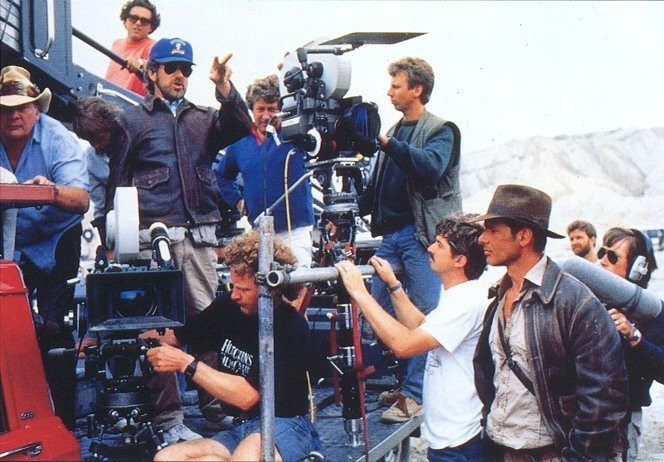
On the set of Indiana Jones and the Last Crusade. Director Steven Spielberg (wearing the blue hat), 1st Assistant Director José Luis Escolar (next to Spielberg in the blue jacket), and main actor Harrison Ford (in the cowboy hat). A 1st AC adjusts a camera (bottom left), a Camera Operator stands-by (center right top), and a Boom Operator stands-by (far right). | Copyright Paramount Pictures 1989
Video Production and Management Department
Think of the production department as the management and client relations part of the team. These people are in charge of the project as a whole: the financials, client satisfaction, and crew/cast management.
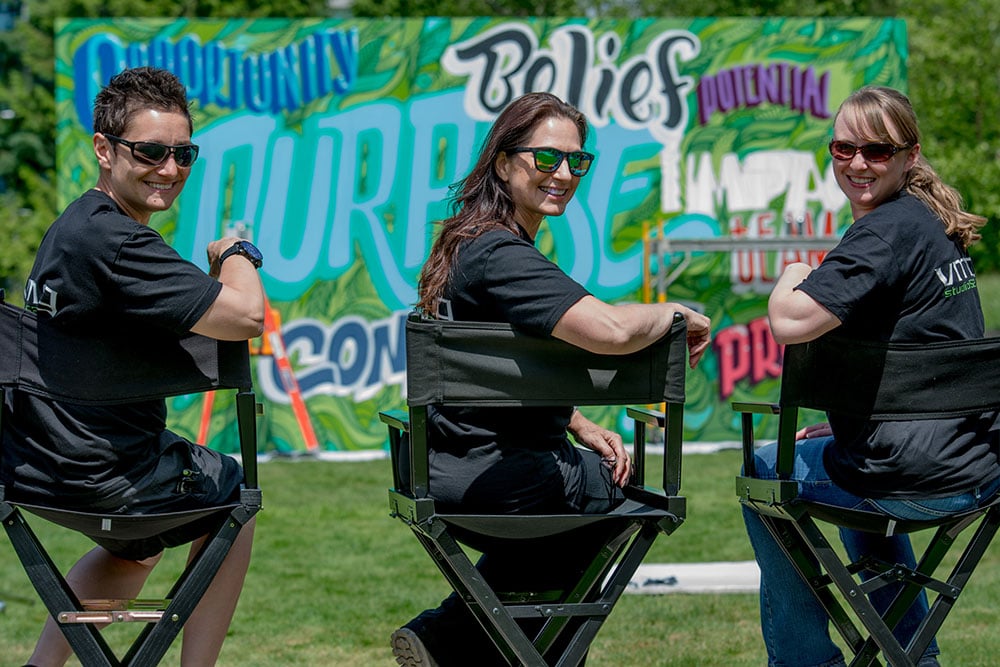
Members of the VMG Studios production team on set. Senior Producer Cyndi Butz-Houghton (left), Executive Producer Kelly Sparks (center), Senior Creative Producer Shawna Mascarelli (right).
Here’s a breakdown of the roles that fall under the Production department.
Client
Yes, the Client is part of the team! Their input, expectations, and feedback are some of the most crucial parts of a successful production. A client could be any entity from a small business owner wanting a local commercial, to a fortune 500 that needs a campaign for their upcoming event, or even a studio itself (think Paramount or Disney).
Executive Producer
Think of this person as the CEO of the project. They’re usually the ones kick-starting the project, securing the financing, and assigning the producer(s). They rarely have any further input besides ensuring the bottom line is met (aka profit and happy clients) and they may or may not show up on set.
For many smaller production studios, the company CEO is usually the Executive Producer.
Producer
Next to the Executive Producer (and in many cases the Client), this person (or persons) is the one with their butt most on the line. If the production flops, it’s on the producer’s head.
They’re the ones in charge of everything from an execution standpoint – maintaining the budget, hiring the Director and department heads, supervising creative and logistics, and otherwise answering only to the Executive Producer and the Client. They’re also the main conduit of communication to and from the Client.
Often, the Producer also has creative input and sees the project from the beginning through post-production.
Associate Producer
The Associate Producer, if there is one, handles much of the overspill from the Producer(s). They’re in charge of managing crew, cast, union contracts, wrangling project schedules, securing permits, and so on.Production Coordinator
Traditionally, the Production Coordinator is only responsible for organization: the logistics of hiring crew, booking talent, renting equipment, etc. They’re typically supervised by a Production Manager.
For VMG Studios’ purposes, the role of the Production Coordinator is slightly modified. Our Production Coordinators help get projects into production, source catering and craft services (which we’ll discuss later on), help with crew hires and casting, and prepare and print any on-set information (like schedules, menus, scripts, production books, etc.).
During shooting, they may also hold crew and talent accountable to their call-times and manage the schedule of anyone off-set (talent in waiting, catering, wardrobe & make-up, etc.).
Production Assistant (PA) – Producers
This is the generic term for any assistant on set. There are many kinds of Production Assistants. A PA in the Production and Management department is essentially a paper runner. They assist the Producer and the Production Coordinator (or the Production Manager, on larger shoots) and wait on the Client hand and foot.
Keep in mind, on small productions, the Producer may assume the majority, if not all, of the roles listed above.
Direction Department
This department somewhat speaks for itself. This is the main creative body – the Director – and all of their support personnel. They’re sometimes listed under the production department and may or may not include all of the roles listed below.
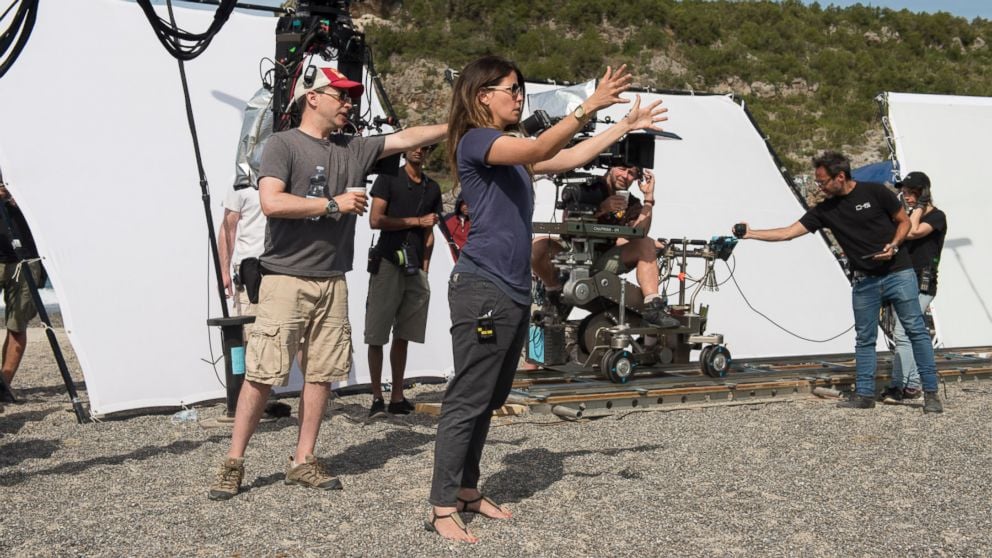 Director Patty Jenkins and 1st Assistant Director Tommy Gormley (red hat) on the set of Wonder Woman. Image Credit: Matthew Jenson | Copyright Warner Bros. Pictures & DC Films.
Director Patty Jenkins and 1st Assistant Director Tommy Gormley (red hat) on the set of Wonder Woman. Image Credit: Matthew Jenson | Copyright Warner Bros. Pictures & DC Films.
Director
This is the person responsible for the execution of the vision. They’re usually the first person the Producer hires onto the project and they weigh-in heavily on who will be hired as department heads.
The Director and Producer(s) often act as a team atop the production pyramid. The Director being in charge of all things creative and the Producer(s) being in charge of all things budget and management. Creatively, the Director answers only to the budget and occasionally the Producer.
In some cases (particularly on smaller productions), the Producer is also the Director. In this case, the title is Producer Director.
Assistant Director (AD)
Contrary to what this title might indicate, the AD is not a Director’s Assistant (as in someone who brings them their coffee and manages their paperwork). The Assistant Director is like the First Officer of the set. Whatever the Director wants, the AD enforces. Whatever the Production Coordinator or Producer has scheduled, the AD enforces (even if that means pushing the Director along to stay on schedule).
Any communication to the Director goes through the AD. Depending on the preferences of the Director, the AD is often the person yelling most of the calls on set (like “roll camera” and “quiet on set!”). They manage call-sheets, shot lists, storyboards, and more, and make sure all departments are prepared for each shot of the day. Their primary job is to ensure the set is operating smoothly so that the Director can focus on directing.
When the Director is unavailable, the AD may also stand in as Director and direct low priority shots, b-roll (supplementary video footage), or background action. Depending on the size of the shoot, there may be more than one AD (1st, 2nd, 2nd 2nd, 3rd, etc.), all of whom answer to the 1st AD.
You might be wondering, “Was 2nd 2nd a typo?” Nope! In the American system, the order of Assistant Directors goes 1st, 2nd, 2nd 2nd, 3rd, 4th. Sometimes, depending on the production and the country you’re in, the 2nd 2nd and the 3rd AD are the same job. But for the most part, in America, it’s 2nd 2nd. Confusing, I know.
Script Supervisor/Continuity
The Script Supervisor works very closely with the Director and AD to make sure that nothing in the script is being missed, that lines are being delivered accurately, and that continuity is being maintained.
For example, that famous episode of Game of Thrones where Daenerys Targaryen left her Starbucks cup on the table (though partially on Emilia Clarke) was primarily on the head of the Script Supervisor for not noticing it.
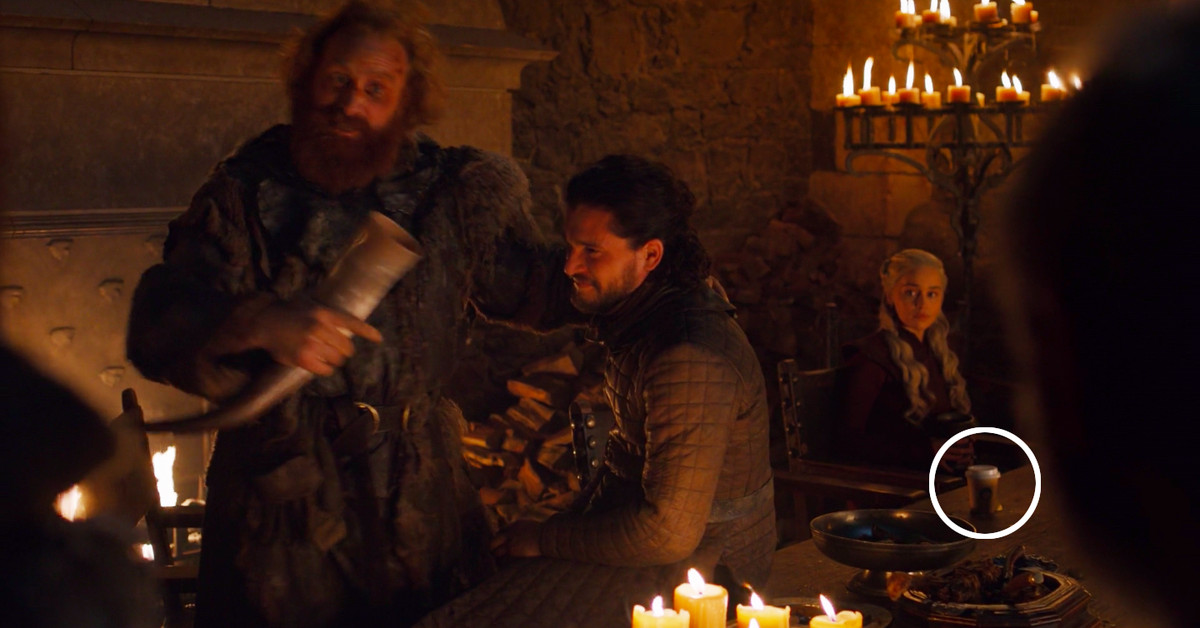
A Starbucks cup appears on Game of Thrones season eight, episode four, “The Last Stark.” Courtesy Vox.com | HBO
The Script Supervisor also takes notes and keeps detailed records of each take (from talent placement, timecode, slate info, and talent delivery, to which lens was used and if the Director liked specific elements). This makes the Editor’s job in post-production easier, giving them a log of takes to track along with the Director’s preferences.
Production Assistant (PA) – Directors
There are two kinds of PA’s that can be assigned to this department: a standard PA, whose job is basically for “as-needed” tasks; and a Key Production Assistant.
The Key PA would be in charge of any other PA’s in the department, reports to the AD’s, may wrangle large amounts of extras, and is training to become a 4th, 3rd, or 2nd 2nd (yep, there’s that weird 2nd 2nd thing again) Assistant Director. Sometimes, the Key PA is called the 4th AD. Like secondary and tertiary ADs, a Key PA will likely only exist on the largest of shoots.
Teleprompter Operator
This role could arguably exist either here, in the camera department, or in the production department. There is no consensus. I’ve placed it here because I personally think a Teleprompter Operator takes more direction from the director or talent than anybody else.
The Teleprompter is a screen that is placed over the camera (or just off-camera) and contains the lines the talent needs to read. This is useful if the talent has a lot of speaking lines and perhaps isn’t a professional talent who’s trained in memorization.
The Teleprompter Operator has what appears to be a fairly simple job: scroll along as the talent reads off the screen. But there’s a bit more to it than that. They need to know the ins and outs of the equipment, the script, and the talent’s speaking/acting habits. They often will attend any rehearsals the Director and Talent may have.
They also specially format the script for the prompter and edit on the fly if needed. A bad prompter operator can negatively affect a talent’s performance.
On small shoots, don’t be surprised if the only people in this department are a Producer Director and a PA who acts as a Script Supervisor.
Camera Department
The camera department is composed of all the people associated with the physical cameras and the footage/media being captured.
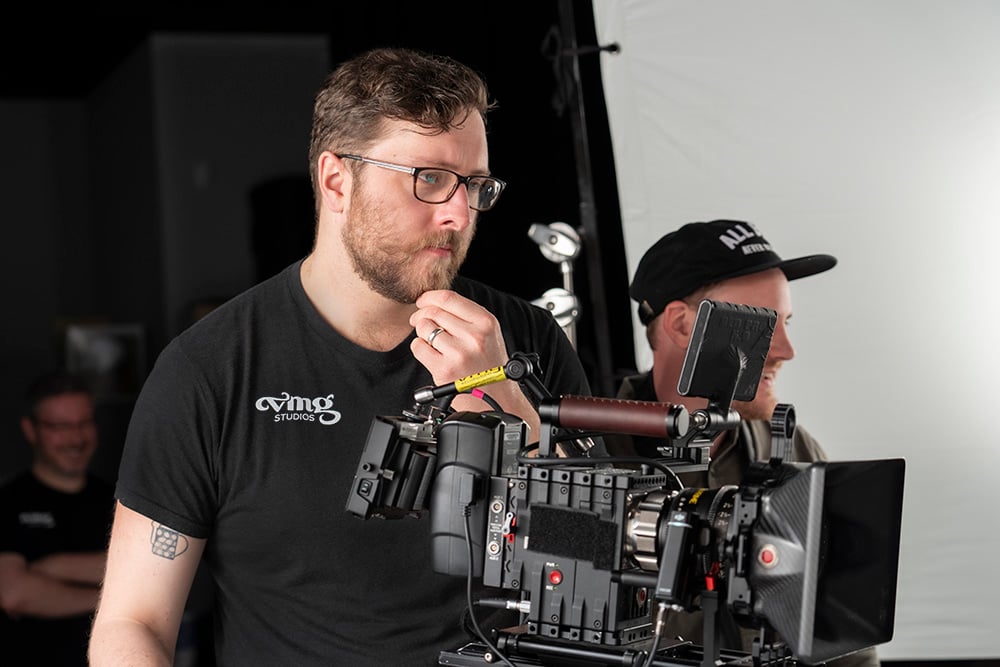 VMG Studios Director of Photography and Cinematographer Hunter Boen considers a shot; on set at VMG Studios.
VMG Studios Director of Photography and Cinematographer Hunter Boen considers a shot; on set at VMG Studios.
Director of Photography (DP)/Cinematographer
Next to the Director, this person is arguably the most important creative force on a Production set. The Director of Photography, or DP, is in charge of interpreting the Director’s vision when it comes to the look and feel of the shots.
They directly interface with the Director and are the lead for everyone else in this department and the Grip & Electric department. They advise the Director on the look and feel, select the equipment that will achieve the desired look, and assign the Camera Ops, AC’s, Gaffer, and Key Grip.
The term Cinematographer is generally used only when the DP is also the lead Camera Operator.
Camera Operator
This person (or people, if there are multiple cameras on the shoot) is an expert on the camera they are using. They’re in charge of maintaining the camera and lenses, following the DP or Director’s vision during a shot, and rolling and cutting appropriately.
Assistant Cameras (AC)
As the AD is to the Director, the AC is to the Camera Operator. The AC is responsible for maintaining or setting up the camera (if the Camera Op is not already doing so), managing media (i.e., labeling cards or film reels and other organization), managing batteries and power for the camera, pulling focus, and updating and clapping the slate/clapper.
On larger shoots, this role may be divided into multiple people: the 1st AC will pull focus and maintain the camera; the 2nd AC will update the slate/clapper and manage the media.
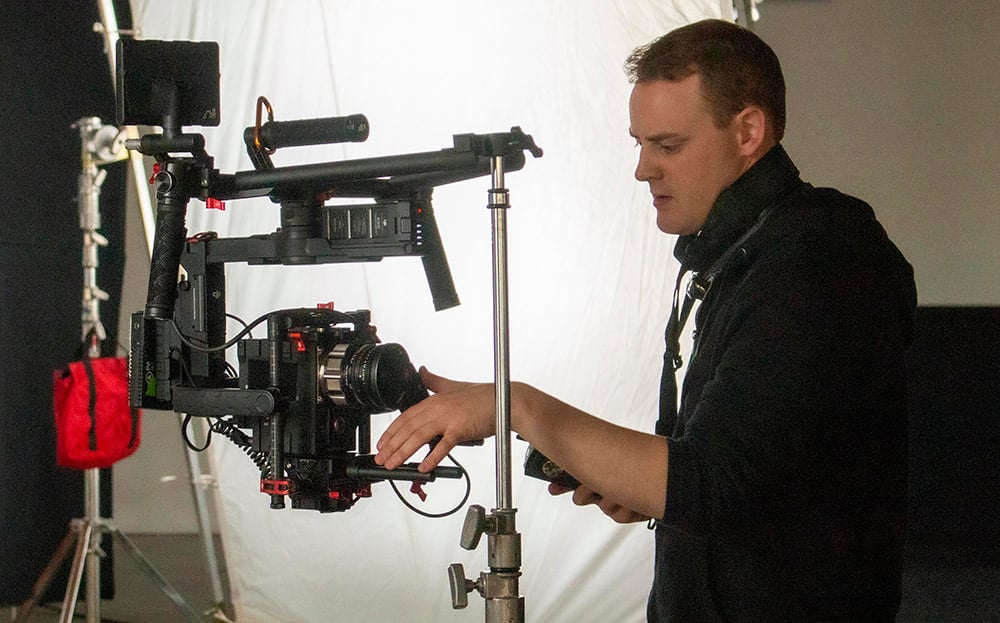
AC Kevin O’Donnell preps the camera on a stabilizer and tests a wireless follow focus; on-location for VMG Studios.
Digital Imaging Tech (DIT)
The Digital Imaging Tech is almost always referred to as DIT (pronounced dee-eye-tee). This role is a product of the transition from film and tape to digital media. Whereas in the past, the 2nd AC could manage the organization of media on their own, nowadays, a DIT is needed to properly manage and back up the production footage.
The 2nd AC will deliver properly labeled cards to the DIT who will immediately backup (in triplicate) the data. They will then either use software that verifies the information was copied accurately or will ingest the footage into software that can preview the footage. It’s their job to verify that the footage transfer is complete and free of corruption. They’ll also backup any audio recorded by the Sound department.
On some sets, the DIT may also advise the DP (especially traditional ones who are more accustomed to film stock) on achieving their desired look using a digital camera.
On smaller productions, the DP may wear all these hats, though it’s recommended to have at least a Cinematographer and an AC.
Grip and Electric Departments
This department is sometimes considered to be a sub-department of the Camera department. It’s split into two categories: Lighting/Electric and Grip.
Lighting/Electric
Lighting is the art of placing lights to achieve the DP’s desired look in a shot. Electric is the technical aspect of providing electricity to the set.
Gaffer
The Gaffer is in charge of working with and fulfilling the DP’s vision for the lighting on set. They’ll also direct the rest of the department in the proper lighting setup and look. They may hire their own people or make recommendations. Many Gaffers “graduate” to DP eventually, and this role is considered a steppingstone to that position.
According to VMG Studios DP, Hunter Boen, the name “gaffer” has a couple of different origin stories. It could either be a contraction of “godfather,” which was a term of respect used with foremen and supervisors in the late 1800s, or from the long metal hook that was used to adjust stage lighting — a “gaff hook.”
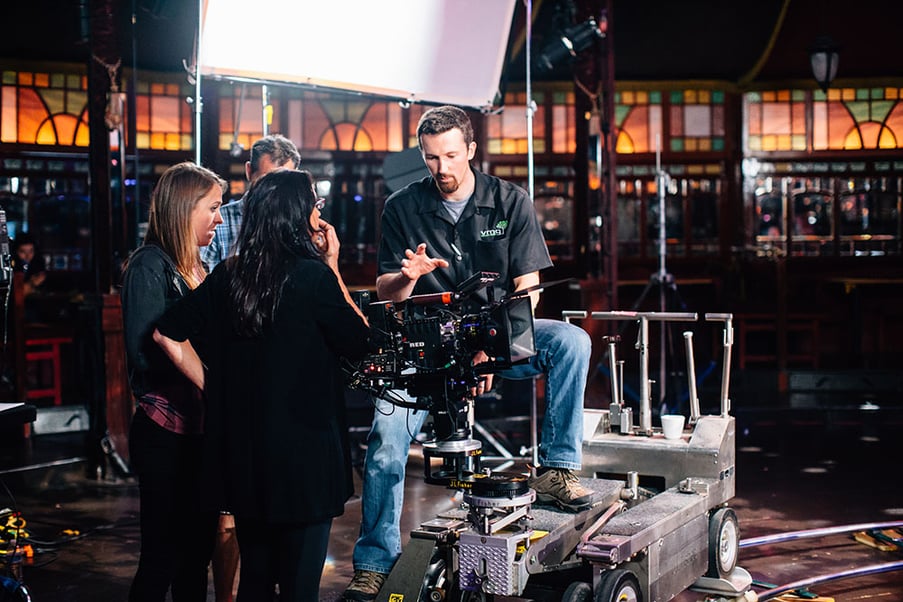
Gaffer Matt Barrett chats with the Director and the DP on a VMG set about the project vision and setup.
Best Boy/Babe – Lighting
The origins of the term “Best Boy” are uncertain. Some believe it originated when the studio would ask the Union to send them their “best boy” for the job. Some think it has origins in sailing. Either way, the Best Boy has become a key role on set and can appear in both the Lighting and Grip departments.
These people manage the hiring and day-to-day management of the personnel and equipment they’re assigned to. In the Lighting Department, they also help the Gaffer direct the Lighting Technicians in the setup. On smaller shoots, they’ll also act as a Lighting Technician and set up lights.
When the Gaffer is unavailable, the Best Boy may also stand in as Gaffer.
A Best Babe or Best Girl is the female version of this role.
Electrical Lighting Technician (ELT)
An Electrical Lighting Technician is someone certified in electrical work who also has an intimate understanding of production lights and equipment. An ELT’s job duties range from setting up lights per the Gaffer’s instructions to wiring electricity from a generator to the talent’s trailer.
They maintain the electrical components of the set from generators to lights and dimmer boards.
On smaller shoots, the Gaffer may fulfill all these lighting roles single-handedly.
Grip
These people are in charge of everything needed to achieve the DP’s vision that isn’t electrical. While they may sometimes move lights around and position them (depending on whether it’s a union job or not), it’s the ELTs who typically first set up the lights and maintain or operate them.
The Grip department is responsible for equipment such as dollies, support vehicles, mounts, rigs, cranes, flags, stands, and anything else needed to make the shot meet the DP’s vision.
While you may feel tempted to move something as simple as a sandbag on set, be careful, that might get you in big trouble with the union.
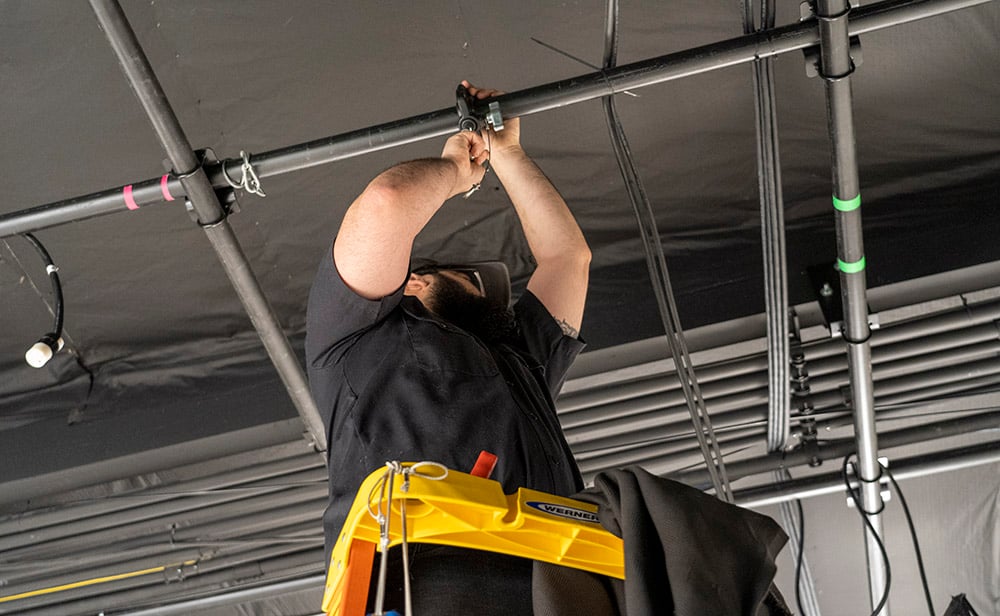
A Grip rigs a mount on the grid at VMG Studios.
Key Grip
The Key Grip is in charge of this department. They may hire their own people or make recommendations. They interface directly with the DP and the Gaffer to develop a plan of execution for the vision.
Best Boy/Babe – Grip
As with the Best Boy for Lighting, the Best Boy for Grip manages personnel and equipment for the Grip department. They’ll also help the Key Grip direct other Grips and can stand in as the Key Grip if the Key Grip is unavailable.
Grips
Grips are the main workforce in this department and literally do the heavy lifting on set. Some Grips have generic jobs, like setting up flags, stands, tracks, and moving lights around. There are also specialized Grips: crane operators, rigging grips, grips in charge of moving camera units on dollies or tracks, etc.
On smaller shoots, there may only be a single Grip and no Key Grip or Best Boy. In this instance, the Grip typically reports to the Gaffer or directly to the DP.
Sound Department
As the name suggests, this department is responsible for acquiring the sound that accompanies the footage shot by the Camera department.
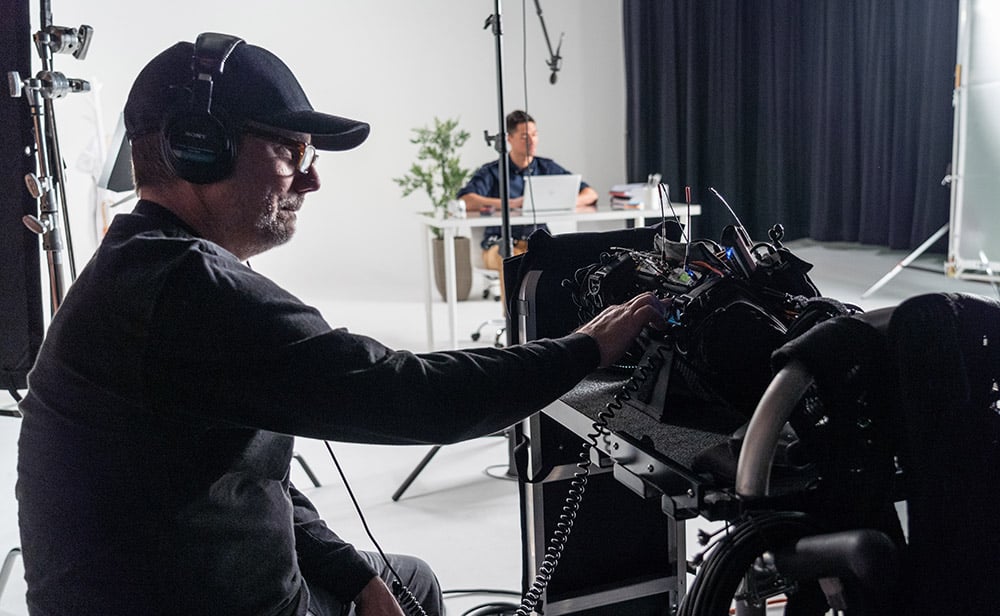 Sound Mixer Brian Olson on set at VMG Studios.
Sound Mixer Brian Olson on set at VMG Studios.
Sound Mixer
This person is the head of the Sound department and is responsible for the sound equipment, operating it, and verifying that the captured sound is of good quality.
The Sound Mixer typically has a separate microphone for each talent and each microphone feeds into a mixer on which they manage the levels (or volume). This is then recorded to a multi-track audio file (or split files) and delivered either to the DIT or straight to the Editor.
They monitor the sound being recorded and advise the Director if each take sounds clean or if there was some kind of noise disturbance that requires another take.
Boom Operator
The Boom Operator is probably the most visibly notable person on a set. They are the person holding the very long pole (called a Boom) with a microphone attached to it.
This person is typically a very fit person. Like the Grips, the Boom Operator needs to be able to hold the Boom pole steady and at varying positions throughout a production.
Quite often, the Sound Mixer and the Boom Operator are the same person, especially on smaller shoots. When this happens, they are often called the Sound Technician.
Art Department
The Art Department is responsible for much of the magic on a production. From set design to hair, makeup, and wardrobe to props and special effects, the Art Department is chock-full of exciting things.
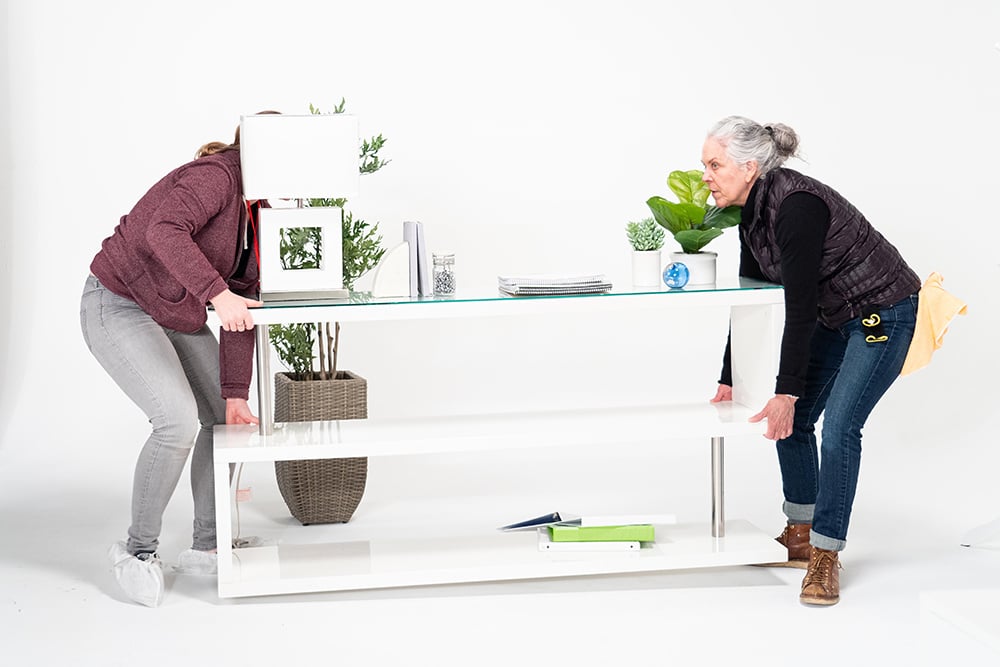 Production Designer and Set Decorator Lisa Hammond (right) arranges set pieces and dressings on set at VMG Studios. A Set Dresser assists.
Production Designer and Set Decorator Lisa Hammond (right) arranges set pieces and dressings on set at VMG Studios. A Set Dresser assists.
Production Designer
This person is in charge of the vision for the Art Department, as set forth by the Director. The Production Designer works closely with the Director and DP to achieve and actualize the project look and feel. They draft creative concepts and schematics, hire or collaborate with the sub-department heads (such as the Art Director, Costumer, Props Master, and Set Designer) and are responsible for literally making or organizing everything that will be on camera.
Under this person are many roles and sub-department heads, not all of which we will go into as you won’t see most of them unless you’re on a very large production.
Key roles & sub-departments typically only seen in medium to large productions:
- Art Director
- Set Designer, Construction, & Scenic
- Set Decorator & Dressers
- Special Effects Supervisors & SFX Assistants/Technicians
Props Master
Depending on the production, you’re more likely to encounter a Props Master before a Set Designer, especially if your shoot is on location at an already existing setting.
Props are any object that is handled or used by an actor or actress in a scene. The Props Master is responsible for sourcing or crafting those objects.
They’ll also assist with the continuity of the props and their placement. On some productions, the Props Master is also responsible for food styling, weapons, and animals. On larger productions, they will have multiple assistants.
On medium-sized shoots, the Props Master may hire a single Prop Assist to help with inventory, staging, and maintenance.
Hair and Make-up
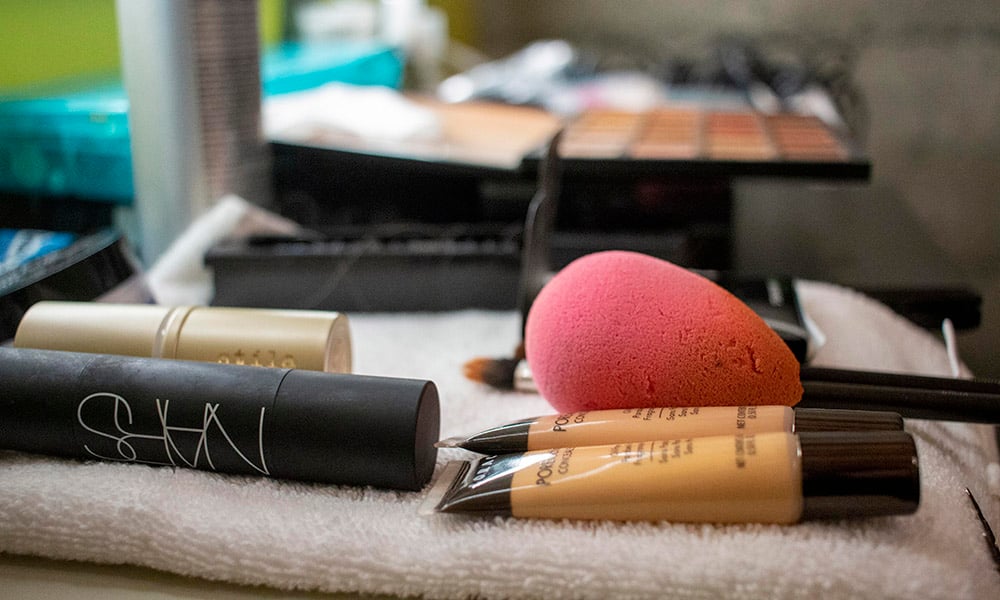 A Make-up Artist’s tools, on set at VMG.
A Make-up Artist’s tools, on set at VMG.
Hair and Make-up are the people you’re most likely to encounter on nearly any production set, regardless of size. On the largest of productions, this department can have multiple people separated by specialty:
- Key Make-up Artist
- Key Hair
- Make-up Supervisor
- Make-up Artists
- Special Make-up Effects Artists (this can be its own sub-dept)
For the most part, you’re likely to encounter only a single Make-up Artist or a 2-person team.
On the smallest of shoots, when there’s no budget for a Make-up Artist at all, a PA who is versed in basic make-up techniques may do simple applications of powder to de-shine an oily face or cover up a small blemish.
Wardrobe/Costumes
Like Hair and Make-up, this department is also one likely to be seen on most sets, though they’re less prevalent than Make-up Artists. Similar to hair and make-up, wardrobe can have its own department separated by specialty on the largest of sets:- Costume Designer
- Costume Supervisor
- Key Costumer
- Costume Standby
- Costume Buyers
- Cutters/Seamstresses
For the most part, you’re likely to encounter only one to three of these people on a medium-sized shoot (a Costume Supervisor, a Costume Buyer, and perhaps a Costume Standby). On the smaller end of things, it’s not uncommon for one person to execute all three roles.
When working under a tight budget at VMG Studios, we sometimes hire one extremely talented individual to be the entire Wardrobe department, the Props Master, and the Set Designer/Decorator. In these instances, we call this person the Production Designer, as a general term. This person will often hire a Prop Assist, who helps them transport, manage, and maintain the individual assets.
Support Department
These people are the unsung heroes of a production set, and quite often they’re everyone’s favorite part: lunch and helping hands.
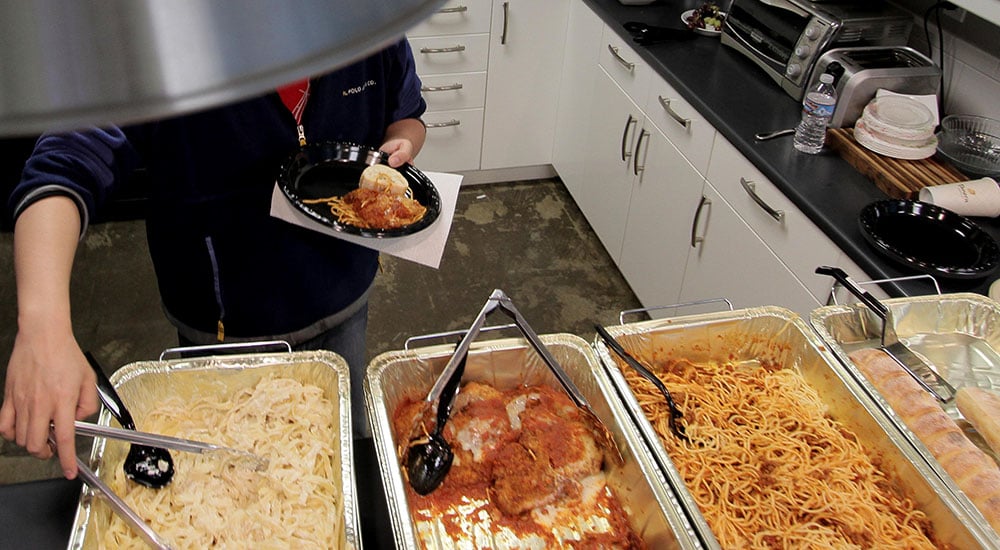 A pasta bar in the kitchen of VMG Studios. Production catering at its yummiest.
A pasta bar in the kitchen of VMG Studios. Production catering at its yummiest.
Catering
As VMG Senior Producer Cyndi Butz-Houghton will tell you, good catering can make or break your production week. Bad food can literally bring a production to a halt if everyone gets sick. That’s why Hollywood-grade caterers are some of the best food preparers in the business.
Often on smaller shoots, a special PA is assigned to Catering and will either run the setup and management of it by themselves (purchasing and running food to the set) or will assist an on-set Caterer.
Craft Services/Crafty
Here’s a term you might not be completely familiar with. “Crafty” is the production jargon term for Craft Services. This is basically the snack table where talent and crew alike can grab a nibble or a drink throughout the day and in-between meals.
Crafty is different from Catering and is run (often) by completely different entities. In addition to food, they may also supply band-aids, gum, antacids, toothpicks, sunscreen, and other sundries.
Typically, a special PA is assigned to keeping the crafty table refreshed with healthy snacks. On larger productions, crafty is managed by special union workers called “crafties.”
Fun Fact: As much as some people claim that the company Kraft got its name from serving as a Craft Services company in the early days of Hollywood, that’s not the case.
Why are film and video productions always providing so much food you might ask? Why can’t everyone just bring their own lunch & snacks? Check out our short article on Catering and Crafty to learn about the efficiency and effectiveness of meal management on your bottom line and on crew morale.
Production Assistant (PA)
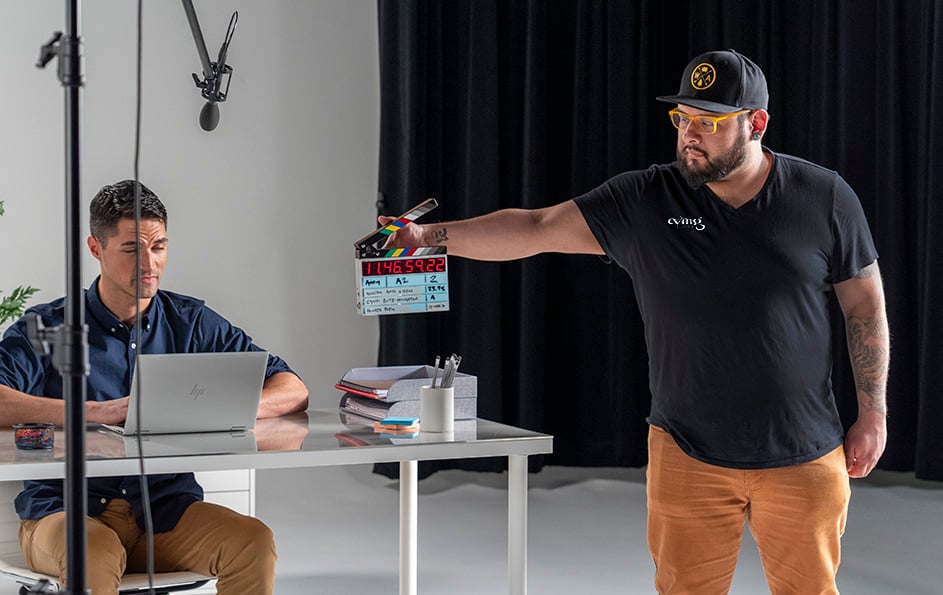 A VMG Studios Production Assistant, assigned to slate, marks the beginning of a take; on set at VMG Studios.
A VMG Studios Production Assistant, assigned to slate, marks the beginning of a take; on set at VMG Studios.
I’ve listed Production Assistants so many times in this article. Why am I listing them again? Because they’re underappreciated and don’t always subscribe to one department.
PAs are typically very young folks who are trying to break into the production world. Some may not know what they want to do yet and will try being a PA for various departments before deciding. If they can get in the good graces of the department they’ve decided they want to work for, they can make their way up those ranks.
Rarely do PAs stay PAs longer than 5 years, as they’re constantly getting promotions. That being said, there are some PA’s who’ve decided to make a career out of the position, and those folks are usually in high demand (they don’t need training, as many PAs do).
On smaller shoots, a PA will wear many hats from crafty to teleprompter to light makeup. A combination Grip PA may also help set up lights, run slate, and move around equipment under the direction of the DP or Gaffer.
Hierarchy and Etiquette on a Video Production
When on-set, there are certain rules of etiquette you’re expected to maintain. One of the most crucial is communication.
All the roles listed above are either in hierarchical order or are laterals, and communication is expected to follow the hierarchy. There are a few exceptions (the main one being the size of the shoot), but for the most part, unless you’re communicating within your own department, you’ll want to start at the bottom of the chain.
For example, if the Production Assistant assigned to catering wants to tell the AD that lunch is ready, they shouldn’t just waltz up to the AD and say so. That PA should approach the PA for the Directors or the Production Coordinator and have them deliver that message.
Similarly, if you want to speak with the Producer or the DP, you must go through their chain of command, starting with their respective Production Assistants (or whoever is lowest on their department’s totem pole). They will decide if it’s appropriate for you to approach the person in question or will carry your message to them themselves.
There are variations of this rule depending on your own role, but this is a good place to start if you’re not certain of the protocol for the shoot you’re on.
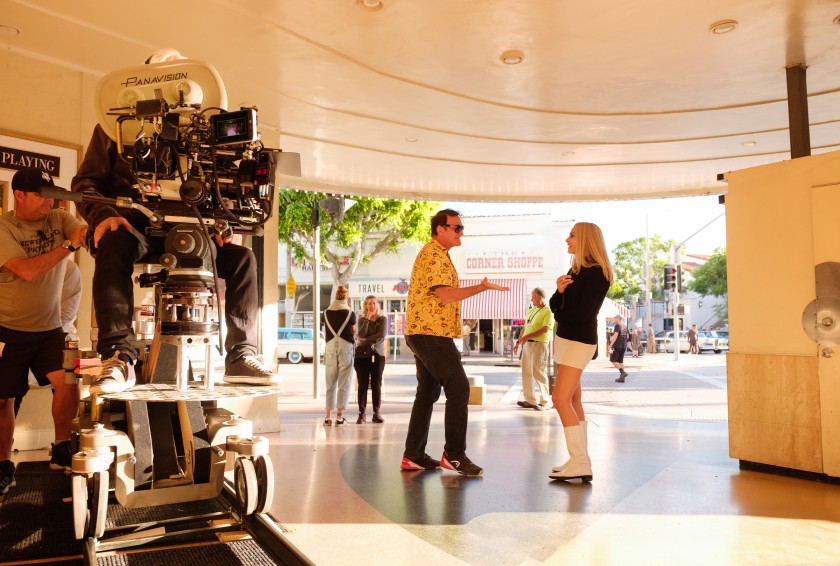 Director Quentin Tarantino and Actress Margot Robbie talking on the set of “Once Upon a Time in Hollywood”. (Andrew Cooper / Columbia Pictures)
Director Quentin Tarantino and Actress Margot Robbie talking on the set of “Once Upon a Time in Hollywood”. (Andrew Cooper / Columbia Pictures)
Under no circumstances should you ever attempt to speak with the client or the talent unless they approach you or you have been given prior permission by the Producer. The same is true in reverse. If you’re a client, it’s recommended that you keep any project-related conversation isolated to the Producer, who can then appropriately disseminate information to the crew.
Production days are often busy and need to move quickly. Following communication etiquette like this ensures that important people aren’t bogged down by unnecessary or untimely communication, especially if your question can be answered by someone else down the line.
For more information on set etiquette & communication, check out our article on production terms and walkie talkie etiquette.
That’s a Wrap!
We’ve discussed many roles here, but there are still many more that we did not discuss. Every production is different, and every studio has different ways of doing things. Unless you’re on a shoot subject to union requirements (where there is very little room for interpretation in a job description), many roles will continue to change, merge, and morph, depending on the studio or the production needs.
Video production can be a foreign and confusing world to a newcomer, but I hope you feel a little more confident now that you understand who all these people are and what they do. Now, go break a leg!
Click the image below to download the free Beginner's Guide to Video Production eBook
